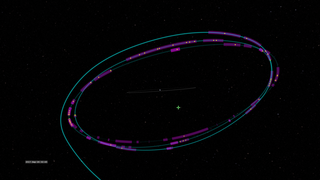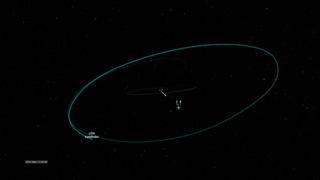Planets and Moons
Universe
ID: 4748
LISA Pathfinder, a mission led by ESA (the European Space Agency) that included NASA contributions, successfully demonstrated technologies needed to build a future space-based gravitational wave observatory, a tool for detecting ripples in space-time produced by, among other things, merging black holes. A team of NASA scientists leveraged LISA Pathfinder's record-setting sensitivity to map microscopic dust shed by comets and asteroids.
These animations follow the trajectory of LISA Pathfinder from Earth to its working "halo" orbit around Sun-Earth L1, a gravitational balance point about 930,000 miles (1.5 million kilometers) from Earth in the sun's direction, and show the locations of 54 dust impacts detected during the mission.
LISA Pathfinder vs Solar System Dust
These animations follow the trajectory of LISA Pathfinder from Earth to its working "halo" orbit around Sun-Earth L1, a gravitational balance point about 930,000 miles (1.5 million kilometers) from Earth in the sun's direction, and show the locations of 54 dust impacts detected during the mission.
Used Elsewhere In
Related
Visualization Credits
Tom Bridgman (Global Science and Technology, Inc.): Lead Data Visualizer
James Ira Thorpe (NASA/GSFC): Scientist
Francis Reddy (University of Maryland College Park): Lead Writer
Scott Wiessinger (USRA): Lead Producer
James Ira Thorpe (NASA/GSFC): Scientist
Francis Reddy (University of Maryland College Park): Lead Writer
Scott Wiessinger (USRA): Lead Producer
Please give credit for this item to:
NASA's Scientific Visualization Studio
NASA's Scientific Visualization Studio
Science Paper:
Micrometeoroid Events in LISA Pathfinder
Short URL to share this page:
https://svs.gsfc.nasa.gov/4748
Data Used:
Note: While we identify the data sets used in these visualizations, we do not store any further details nor the data sets themselves on our site.
Keywords:
SVS >> Asteroid
SVS >> Comet
SVS >> Dust
SVS >> Hyperwall
SVS >> Astrophysics
SVS >> Lagrange Points
NASA Science >> Planets and Moons
NASA Science >> Universe
SVS >> LISA Pathfinder
SVS >> Micrometeoroids
Micrometeoroid Events in LISA Pathfinder
Short URL to share this page:
https://svs.gsfc.nasa.gov/4748
Data Used:
SPICE Ephemerides also referred to as: SPICE Ephemerides
Ephemeris - NASA/JPL
Satellite and planetary ephemerides
Keywords:
SVS >> Asteroid
SVS >> Comet
SVS >> Dust
SVS >> Hyperwall
SVS >> Astrophysics
SVS >> Lagrange Points
NASA Science >> Planets and Moons
NASA Science >> Universe
SVS >> LISA Pathfinder
SVS >> Micrometeoroids













